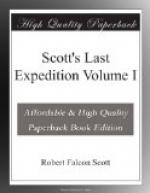Taylor gave a most interesting lecture on the physiographic features of the region traversed by his party in the autumn. His mind is very luminous and clear and he treated the subject with a breadth of view which was delightful. The illustrative slides were made from Debenham’s photographs, and many of them were quite beautiful. Ponting tells me that Debenham knows quite a lot about photography and goes to work in quite the right way.
The lecture being a precis of Taylor’s report there is no need to recapitulate its matter. With the pictures it was startling to realise the very different extent to which tributary glaciers have carved the channels in which they lie. The Canadian Glacier lies dead, but at ‘grade’ it has cut a very deep channel. The ‘double curtain’ hangs at an angle of 25 deg., with practically no channel. Mention was made of the difference of water found in Lake Bonney by me in December 1903 and the Western Party in February 1911. It seems certain that water must go on accumulating in the lake during the two or three summer months, and it is hard to imagine that all can be lost again by the winter’s evaporation. If it does, ‘evaporation’ becomes a matter of primary importance.
There was an excellent picture showing the find of sponges on the Koettlitz Glacier. Heaps of large sponges were found containing corals and some shells, all representative of present-day fauna. How on earth did they get to the place where found? There was a good deal of discussion on the point and no very satisfactory solution offered. Cannot help thinking that there is something in the thought that the glacier may have been weighted down with rubble which finally disengaged itself and allowed the ice to rise. Such speculations are interesting.
Preparations for the start of the Crozier Party are now completed, and the people will have to drag 253 lbs. per man—a big weight.
Day has made an excellent little blubber lamp for lighting; it has an annular wick and talc chimney; a small circular plate over the wick conducts the heat down and raises the temperature of combustion, so that the result is a clear white flame.
We are certainly within measurable distance of using blubber in the most effective way for both heating and lighting, and this is an advance which is of very high importance to the future of Antarctic Exploration.
Tuesday, June 27.—The Crozier Party departed this morning in good spirits—their heavy load was distributed on two 9-feet sledges. Ponting photographed them by flashlight and attempted to get a cinematograph picture by means of a flash candle. But when the candle was ignited it was evident that the light would not be sufficient for the purpose and there was not much surprise when the film proved a failure. The three travellers found they could pull their load fairly easily on the sea ice when the rest of us stood aside for the trial. I’m afraid they will find much more difficulty on the Barrier, but there was nothing now to prevent them starting, and off they went.




